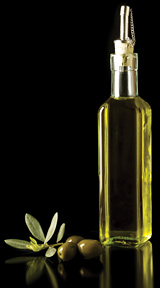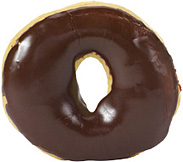Good Oils, Bad Oils
Make Sure You Know the Difference
By Sara Tiner
Ever downed a cheesy slice of pizza, dipped a piece of bread in olive oil or enjoyed a vinaigrette dressing drizzled over a salad? Chances you've eaten at least one (if not all) of the above, which means you know oil makes food taste better. And better yet, we need it! The fat found in oil is broken down by our body for energy and a host of vital processes. But with that said, we have to monitor our oil intake carefully, because consuming too much or the wrong kind can lead to serious health problems. The Chemistry of Oil Oil is primarily fat, with some trace vitamins and minerals. While that may not sound too impressive, it's an excellent food for our body: Fat is the most efficient source of energy, every cell membrane in the body contains fat, skin and hair are fed with it, and it helps us absorb fat-soluble vitamins. To understand how to make the best oil choices to support our body's needs, we need to delve into how the fats in oil are structured.
 Oils are made up of fat, which is (in part) made up of fatty acids. Fatty acids are simply chains of hydrogen and carbon atoms. Fatty acids with only single chemical bonds between carbon atoms are "straighter" and can be packed together tightly, meaning that they're solid at room temperature. These are saturated fatty acids and usually come from animal sources.
Oils are made up of fat, which is (in part) made up of fatty acids. Fatty acids are simply chains of hydrogen and carbon atoms. Fatty acids with only single chemical bonds between carbon atoms are "straighter" and can be packed together tightly, meaning that they're solid at room temperature. These are saturated fatty acids and usually come from animal sources. Unsaturated fatty acids, usually from vegetable sources, have a double bond between carbons called a "cis" bond. This double bond means the carbon molecules aren't holding onto as many hydrogen atoms as they could. This bond also puts a "kink" in the fatty acid that prevents it from lining up as tightly, so unsaturated fatty acids are liquid at room temperature. If a fatty acid has one double bond it is a "monounsaturated" fatty acid; if it has more than one, it is a "polyunsaturated" fatty acid. When an unsaturated fat is chemically changed to have a "trans" bond instead of a "cis" bond, it's is called a "trans fat" or "trans fatty acid." This converts it from a liquid into a solid, and it begins to act more like a saturated fat, although it affects health differently. While trans fats do occur naturally, the vast majority are used in processed foods to extend shelf life or improve texture. Trans fats may also be labeled as "hydrogenated" or "partially hydrogenated." How Fats Function in the Body Fatty acids are broken apart during digestion and absorbed primarily in the small intestine. They're handled differently from other food components like carbohydrates or proteins. The fat we eat is broken apart into its components (such as triglycerides) and repackaged into "lipoprotein" packets (mixtures of cholesterol, protein and triglyceride). You're probably familiar with the following: Low-density lipoprotein (LDL) cholesterol or "bad cholesterol" contains the highest amount of cholesterol of the lipoproteins. LDL carries cholesterol from the liver to the rest of the body. High-density lipoprotein (HDL) cholesterol or "good cholesterol" contains the highest amount of protein of the lipoproteins. HDL picks up cholesterol in the bloodstream and any deposits of LDL and takes it all back to the liver for disposal. These packets flow into vessels that transport them around the body, where cells can pull the triglycerides or cholesterol from the lipoprotein packets as needed. How Fats Affect Health Quantity is key: If too many lipoprotein packets are circulating, they can stick to body tissues (like organs or artery walls). Over time, these deposits can contribute to cardiovascular disease. Additionally, excess fat is stored in fat cells and contributes to health problems associated with obesity. So, too much fat is bad, but too much "bad" fat can make a bad situation worse. Saturated fats raise HDL, but they also raise LDL. Trans fats actually increase LDL, and research suggests they may also lower HDL and increase triglycerides in the blood. This research is backed up by epidemiological studies suggesting that a diet high in trans fats contributes to heart disease and the risk of developing diabetes. On the other hand, evidence suggests monounsaturated and polyunsaturated fats may protect against these diseases. Choosing "Good" Oils: Three Rules While choosing what to eat is getting more and more complicated, there are three simple rules to help you choose the oils that will help, not hurt: - Avoid oils that are high in trans fats. Stay away from food or cooking oils that contain trans fats. Avoiding trans fats should be easier now that they must be listed on labels, but beware: "0 trans fats" means there could be up to .5 g in each serving. Since the American Heart Association suggests you get less than 1 percent of your calories from trans fats, for a 2,000 calorie diet that would be about 2 grams (18 calories). So, after four servings of a zero-trans-fat food, you could theoretically hit your limit.
- Limit saturated fat in all forms. Since our body makes saturated fats, we don't necessarily need to eat them. Most of these fats are found in meat and whole-fat dairy products like milk, cheese, yogurt, and ice cream; however, some oils, like coconut, are particularly high in saturated fat. Saturated fats have been linked to elevated LDL and cardiovascular disease.
- Stick to the serving size. For cooking oil, one serving is a tablespoon - not a sweeping flourish or a "glug-glug-glug" into the pan. In that tablespoon are 14 grams of fat, or 126 calories. That's as many calories from fat as a large slice of pizza, or to put it another way, 15 minutes of moderate running (more or less, depending on your weight; but you get the picture, right?).
For adults, the Food and Drug Administration recommends between 5 (about 1 ½ tablespoons or 21 g) and 7 teaspoons (just over 2 tablespoons or roughly 28 g) of oil a day depending on age and gender. This includes oil from all sources (food, cooking oil, and condiments). For fat in general, the American Heart Association suggests you should get no more than 25-35 percent of your total calories from all types of fat. For a 2,000 calorie diet, that breaks down to less than 16 g of saturated fat, less than 2 g of trans fat, and between 50 and 70 g of total fat each day. What Are Some Good Oil Choices? Compared to less healthy fats/oils, mono- or polyunsaturated fats can be considered "good" oils. These are from plants, nuts, or seeds and can contribute to a healthy diet in a variety of ways.
 Omega-3 and Omega-6 fatty acids. The current stars of the "good" oil world are "omega-3" and "omega-6" fatty acids. These polyunsaturated fatty acids are so named because they have a double bond after the third carbon and the sixth carbon, respectively. Because our body can't synthesize them from other constituents, we need to get them from our diet.
Omega-3 and Omega-6 fatty acids. The current stars of the "good" oil world are "omega-3" and "omega-6" fatty acids. These polyunsaturated fatty acids are so named because they have a double bond after the third carbon and the sixth carbon, respectively. Because our body can't synthesize them from other constituents, we need to get them from our diet. Omega-3 fatty acids: The most widely studied omega-3 fatty acid is alpha-linolenic acid (ALA), which can be made into two longer fatty acids called EPA and DHA. These are the omega 3s you'll get from fish and fish oil supplements. Increased omega-3 intake is solidly associated with lower cardiovascular disease risk and a lowered risk of heart attack/sudden death in people with coronary heart disease. Additionally, research suggests that omega-3 supplementation maybe helpful for treating type 2 diabetes, as well as joint tenderness in people with rheumatoid arthritis. Omega-3 fatty acids are also being studied as an adjunctive treatment for Alzheimer's disease, dementia, depression, bipolar disorder, and schizophrenia. They can be found in flaxseeds (ground or oil), walnuts (whole nuts or oil), and canola oil. Fish like herring, salmon, and oysters have high levels of EPA and DHA. Omega-6 fatty acids: Omega-6 fatty acid is also called linoleic acid (LA). Safflower oil, pine nuts, pecans, and sesame oil are good sources of LA. These fatty acids have been associated with lowering the risk of coronary heart disease in a number of studies. Other research demonstrates that omega-6s can lower total and LDL cholesterol in some people. Research continues to find tantalizing ways in which these fats complement treatment of chronic conditions. For example, in a recent study published in the American Journal of Clinical Nutrition, obese, postmenopausal women diagnosed with type 2 diabetes were asked to take a safflower supplement containing 6.4 g of LA per day. The researchers reported that this supplement was associated with a reduction of torso fat, lowered blood sugar markers, and increased muscle tissue after 16 weeks. Olive oil. Olive oil is another good oil. It has a solid research pedigree and a great taste. Olive oil is made up of monounsaturated fats, which have been linked to reducing LDL cholesterol, as well as a number of other health-promoting compounds like iron, phytosterols (cholesterol-like compounds found in plants), vitamin K, and polyphenols (antioxidant compounds found in fruits, vegetables, and some nuts). All types of olive oil contain the same amount of fat, so it doesn't matter if you prefer virgin or extra-virgin; go with what tastes best to you. Supplements Supplements can be a good choice for people who don't regularly eat the foods that contain essential fatty acids. If you choose supplements, you have an ever-growing range of choices. For omega-3 fatty acids, a common recommendation is to take 300-500 mg of EPA and DHA, and 800-1,100 mg of alpha-linolenic acid. While you'll most often see EPA and DHA in tuna oils, flaxseed oil is an excellent source of ALA. There is no standardized recommendation for omega-6 fatty acids, although some suggest that a ratio of 2:1 to 4:1 (omega-6 to omega-3) is a good target. Other good oils are wheat germ, an excellent source of choline and vitamin E; and safflower oil, the kind high in linoleic acid. Make Healthy Choices Every Day Diet has always played a key role in health. In the past (and in some areas of the world still), dietary deficiency has typified this relationship. But in the United States, dietary excess is the growing (and growing, and growing) problem. Paying attention to the type of fat we include in our diet can make a real difference in our health - by their therapeutic use in chronic condition management and by helping diversify our diet. Adding healthy oils to a smoothie or salad dressing might jazz them up enough so they become part of our daily diet which, in turn, helps us eat more fruits and vegetables. So get creative with oils and experiment with ways of using them to improve your breakfast, lunch and dinner. You have nothing to lose, and a whole world of taste to gain.
 How Much Is Too Much?
How Much Is Too Much? Here's the maximum amount of fat you should consume (in grams) on a daily basis from oils and other sources: - 2,000 calories (average per day) x 0.3 (maximum of 30% of calories should come from fat) = 600 fat calories per day
- 600/9 (nine calories per fat gram) = 67 grams of total fat per day
What's in Your Oil?
Fatty acid distribution is a fairly good indicator of whether an oil is better or worse for you, at least in terms of its relationship to cholesterol and cardiovascular disease. In general, the less saturated fat and the more monounsaturated/polyunsaturated fat, the better. Here are the fatty-acid profiles for various oils per serving (1 tablespoon; 13.6 grams): | Type of Oil | Fatty Acids, Total
Saturated (grams) | Fatty Acids, Total
Monounsaturated (grams) | Fatty Acids, Total
Polyunsaturated (grams) | | Almond | 1.115 | 9.506 | 2.366 | | Canola | 1.031 | 8.859 | N/A | | Coconut | 11.764 | 0.789 | 0.245 | | Corn | 1.761 | 3.75 | N/A | | Grapeseed | 1.306 | 2.19 | 9.506 | | Olive | 1.864 | 9.85 | 1.421 | | Peanut | 2.28 | 6.24 | 4.32 | | Safflower | 0.844 | 1.952 | 10.149 | | Sesame | 1.931 | 5.399 | 5.671 | | Walnut | 1.238 | 3.101 | 8.609 | | Wheat Germ | 2.557 | 2.054 | 8.391 | | Source: USDA Agricultural Research Service Food and Nutrient Data Laboratory |
Sara Tiner, BA, BS, MS, is the coordinator of scientific communication for a whole-food supplement manufacturer in Wisconsin. With undergraduate degrees in biology and English from Ripon College, and a master's degree in journalism from Columbia University, she's worked as a science writer in both print and radio over the past decade, and moonlights as a freelance contributor to various publications.
Page printed from:
http://www.toyourhealth.com/mpacms/tyh/article.php?id=1258&no_paginate=true&no_b=true
|

